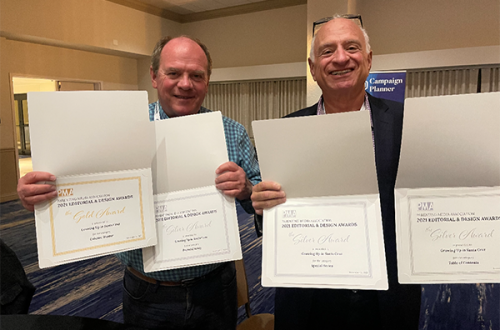Parents and students mistakenly believe that taking AP classes is equivalent to taking college courses, and that taking a full load of them will improve their chances of getting into selective colleges. People hear rumors and spread inaccurate information. Here is the real scoop on AP courses and how to get into top colleges:
Problem with AP Courses:
AP Classes are NOT college-level:
Some students believe that by taking AP classes in high school they will be able to skip the same subject introductory courses in college. While this may sound good, AP classes only cover about a third or a half of what is taught in college classes. When entering freshmen use AP classes to skip college courses, they are pushed into classes that they may not be prepared to take.
Other students in those upper division college courses took the college’s introductory courses and they’re much better prepared to succeed. They’ll get better grades and be more competitive for grad school admissions. Many colleges do NOT allow AP courses to replace intro courses, and for those that do, most don’t include the high school AP grades in the college GPA.
Memorizing facts for the May AP exam is brain numbing:
Students across the nation study for eight months to take the same standardized AP exam in May. The “good” AP teachers understand exactly what the students need to learn to receive a “5” (1-5 scale) on this high-stakes exam. They prepare detailed worksheets and study guides, and they give the students dozens of practice AP exams. Classes are organized to cover every aspect of the specific concepts.
Students memorize facts, write annotated notes (which takes hours each day), and take practice exams until they consistently score 5s. Unfortunately, these teachers don’t have time to explore the concepts or delve into meaningful conversations with the students. Learning how to write research papers is scraped in lieu of cramming facts into the minds of otherwise curious teens. Students don’t have the opportunity to explore subjects and possible careers.
Wealthy students have an unfair advantage:
AP classes quickly cover lots of material. Many wealthy students have the luxury of tutors who review the concepts and give tips on acing the exam. Poor students certainly can’t afford private tutors, expensive workbooks and flashcards. AP teachers in high schools for disadvantaged students often don’t have the resources or networks to offer students quality AP guidebooks. Many students in these schools don’t pass the AP exams and as a result, they don’t apply to college. So the “haves” get better teachers, more resources and go to college, while the “have-nots” don’t have AP course support to succeed and aren’t college bound.
Colleges want students who take the most challenging courses:
When colleges have single-digit admit rates, naturally they will choose students who have taken and succeeded in difficult classes. Unfortunately, most high schools only offer AP, honors and regular classes. So to be competitive high schools started offering more AP courses. When students have the opportunity to enroll in 20+ AP classes, many take 4-5 AP classes every semester.
Doing well in 20 AP classes requires a ridiculous number of hours to study each day, which eliminates opportunities for high school students to explore their interests and develop interpersonal skills. So the more AP classes taken, the less interesting their college application is because they aren’t standing out among their peers and they certainly are not demonstrating their intellectual prowess.
If not AP classes, how to stand out?
Community College classes:
Instead of getting weighed down by fact-memorizing courses, students can enroll in college classes at local community colleges that are taught by teachers who aren’t bound by AP study guidelines. Students learn to take good notes because they’ll need them for midterms and final exams. They’ll demonstrate their comprehension and share their thoughts by writing essays. Every college class grade is weighted and most colleges will accept community college courses for credit. These community college transcripts will be submitted to all higher education admissions (grad schools) in the future unlike AP exams that only count for freshman admission.
Projects:
The best way to stand out to college admissions officers is to focus on something unique that shows intellectual curiosity, unwavering tenacity, and personal drive. Start and complete a project outside of school and clubs that demonstrates grit and integrity. Colleges are intrigued when students do something that is not a class assignment or club requirement.
Start a project early in high school so there’s plenty of time for mistakes, changes, and success. Check out Merit’s student projects.
Take Away:
Many colleges are discouraging students from overloading on AP classes. They’re seeing the negative effects of this trend as students hope to enter college at a sophomore or junior level with their transcripts filled with AP classes. They know that these students are not as prepared as other students who take the college’s introductory courses during their freshman year.
Colleges are looking for innovative students who focus on their personal interests and reach their goals. These types of students do well in elite colleges because they engage with their professors, don’t ask for or need study guides, and dive into research and innovative ideas.
Only take AP classes that are genuinely interesting and then follow up with college courses in the same areas to learn more. Start independent projects to discover solutions and do it with passion. Colleges don’t want robots trained to memorize and regurgitate facts, they’re looking for students who will come ready to network with other brilliant students.
Susan Tatsui-D’Arcy is the founder of Merit Academy (one-on-one classes)and Merit Educational Consultants (college and educational advisory). She has written books on projects, free child care, education, and parenting. Susan hosts TEDxMeritAcademy for students to present their innovative projects and solutions. In 2019, she was California Mother of the Year.meritworld.com








